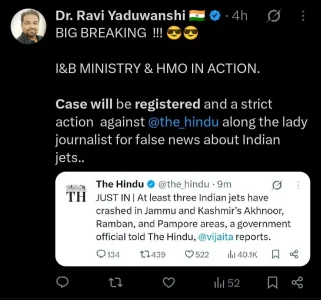Operation Sindoor & Aftermath (21 Viewers)
- Thread starter haldilal
- Start date
More options
Who Replied?- Joined
- May 8, 2025
- Messages
- 121
- Likes
- 868
No I am asking about Pak troop/asset deployment near IB in Sindh.No indian troop movement
- Joined
- Nov 30, 2024
- Messages
- 375
- Likes
- 3,697
Another one
Utter humiliation
View: https://x.com/khalid_pk/status/1920373531264565393?t=RCqLgeFD41YwRIwExrT0ag&s=19
Utter humiliation
View: https://x.com/khalid_pk/status/1920373531264565393?t=RCqLgeFD41YwRIwExrT0ag&s=19
- Joined
- Jul 1, 2024
- Messages
- 564
- Likes
- 5,388
Please for the love of God, members here should stop posting the same Tweet twice and stop ChapGPT on this forum. Post from authenticated sources and any developments from other handles. There is flood of duplicate posts and ChatGPT creeping in to the thread.
- Joined
- Jun 30, 2024
- Messages
- 970
- Likes
- 2,639
- Joined
- Jun 27, 2024
- Messages
- 3,009
- Likes
- 10,752
️ Flight operations at Islamabad, Karachi, Lahore, and Sialkot airports have been completely suspended due to escalating security threats.
View: https://x.com/pakistanwalli/status/1920367745780052381?s=19
This is the best strategy of India:
Keep Pakistan on edge, compel them to divert focus from trade and economic activity, ultimately crippling local industries and bring their economy and population to its knees.
Keep Pakistan on edge, compel them to divert focus from trade and economic activity, ultimately crippling local industries and bring their economy and population to its knees.
- Joined
- Jun 27, 2024
- Messages
- 4,330
- Likes
- 25,308
Ya'll Nibbiars their whole propaganda machinery going into dust, lol, paki got the taste of their own medicine.
View: https://x.com/amanroutray7/status/1920375339198361631
View: https://x.com/amanroutray7/status/1920375339198361631
- Joined
- Jun 30, 2024
- Messages
- 970
- Likes
- 2,639
- Joined
- Jul 1, 2024
- Messages
- 564
- Likes
- 5,388
Don't we have electronic jammer which can destroy a waves of drones in one go
You can jam their GPS which relies on electromagnetic signals. But you can't jam inertial guidance systems which doesn't emit any EM waves. Some of the drones might be unguided too. We don't know what kind of drones they have or whether they have used them at all in this conflict.
- Joined
- Jun 27, 2024
- Messages
- 4,330
- Likes
- 25,308
- Joined
- Jul 3, 2024
- Messages
- 457
- Likes
- 3,405
Humiliation and loss of face of army in front of their awam is much more potent than any economic loss.This is the best strategy of India:
Keep Pakistan on edge, compel them to divert focus from trade and economic activity, ultimately crippling local industries and bring their economy and population to its knees.
I say keep escalating. Drones, artillery, more aggressive strikes. We need to find out how much we can push till international powers intervene or Pakistan actually mobilizes. Till then we need to keep pressing and keep humiliating.
- Joined
- Jul 1, 2024
- Messages
- 869
- Likes
- 5,111
Israelis are having the laugh on porkies
Their harop kamikaze fucking mard me momin Lahore Air defence battery
- Joined
- May 8, 2025
- Messages
- 36
- Likes
- 299
- Joined
- Jul 1, 2024
- Messages
- 869
- Likes
- 5,111
Out defence and MSM journalist haven’t reported anything on poonch and looks not interested or govt have advised not to. There is CFV going on across LoCWhat is happening on LOC? Any ceasefire violations today? Any misadventures? No news on this front from our Defense journalists so far
- Joined
- May 8, 2025
- Messages
- 121
- Likes
- 868
I miss Asif Ghafoor sometimes.DJ ISPR press conference going on
He was a good entertainer.
- Joined
- Apr 24, 2025
- Messages
- 178
- Likes
- 788
I will advice people to be inside their homes near air force bases in northern india as sirens are going on and police telling people to be vigilante and stay inside .
Drone attack is expected from porkistan.
Drone attack is expected from porkistan.
- Joined
- Jul 6, 2024
- Messages
- 258
- Likes
- 2,257
Seems PAF SAM battle control system destroyed by
Indian drones
View: https://x.com/mitrapredator/status/1920373929115312134?t=b0qb9SP5JAI3_ug9jpQ3Tg&s=19
Indian drones
View: https://x.com/mitrapredator/status/1920373929115312134?t=b0qb9SP5JAI3_ug9jpQ3Tg&s=19
- Joined
- Apr 23, 2025
- Messages
- 285
- Likes
- 1,637
Thinking about this absolutely no one has done RR and asked specifically us to de-escalate or show restraint, its "both".international powers intervene
- Joined
- Apr 24, 2025
- Messages
- 178
- Likes
- 788
7 pakistani civilains or soldiers died in cross artilery fire in poonch sector yesterday reported by pakistani news dawn .Out defence and MSM journalist haven’t reported anything on poonch and looks not interested or govt have advised not to. There is CFV going on across LoC
indian army giving a thorough pounding in poonch.
Users who are viewing this thread
Total: 16 (members: 4, guests: 12)
Latest Replies
-
Chinese Economy Watch
- E-195
-
Indian Economy
- swesh Annonamys Sanatani
-
Failed Terrorist Beggar State of Pakistan: Idiotic Musings
- vin pahadi (kumauni)
-
Idiotic Musings from the West
- swesh Annonamys Sanatani
-
Operation Sindoor & Aftermath
- neelaslayer
-
DRDO & PSUs
- snakeeyes07
-
Tracking Indian Judiciary: News, Updates & Discussions
- swesh Annonamys Sanatani
-
Naxal Maoist Insurgency
- swesh Annonamys Sanatani
-
Sinking State of Bangladesh: Idiotic Musings
- The Juggernaut
-
Russian Ukrainian War
- Soldier35


